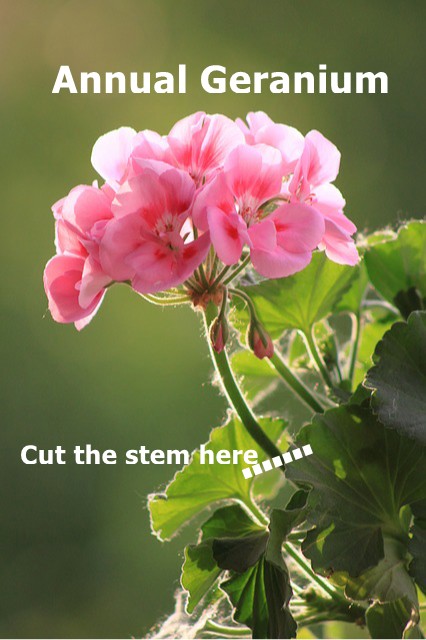While you might think “Deadheading” is a reference to the Grateful Dead, it actually means removing the flowers that are spent or past. When you deadhead the plants in your container gardens or flower beds, you want to remove the dead flower and all of its parts off the stem. Annual plants spend their whole lives trying to reproduce. When you get the seed pod off of the plant before the seeds mature, the plant will produce more flowers constantly trying to make more seeds.
For geraniums, get ahold of the flower ray and quickly bend it down or backward from the stem. It will snap off at the stem; if it doesn’t want to snap off easily, use your scissors and cut it off. See the picture, below.
For salvia, snapdragons and other spike flowers, remove the spent flowers at the base of the spike or lower. Even if just the top of the flower spike is still looking good, cut it off anyway because the bottom flowers are already working on their seeds. Snapdragons can be tricky to tell if they’re coming or going. If there’s a little thread coming out of the nub, it’s a seed pod. The flower buds look similar but without the thread. Fun fact: when snapdragon seed heads mature and release their seeds, the look like tiny skulls.


Dianthus, nemesia, flowering tobacco and some marigolds have little flowers on wiry stems. When these are done, I take my scissors, hold on to the plant with my left hand and cut all the flower stems off at once. It’s best to do this in the evening so if you cut through any leaves they don’t burn in the sunlight.
The hardest flowers to figure out what to do with are petunias. When their flowers are done, they often fall off or pick off really easily; however, petunias have a tendency to get “leggy.” Scroll down for more information on caring for and cutting back petunias.
When deadheading roses, don’t be too gentle. Remove the spent flower back to the first leaf with 5 leaflets and cut at an angle away from the leaf. If your rose bush is getting too large, however, you can cut it back further to promote strong stems.
In the perennial flower bed, you may want some of the plants to form and drop seeds. Penstemon (Beardtongue), for example, is generally a short-lived perennial but will re-seed if you allow the spent flower stocks to stay on the plant until the seeds mature and drop. Other plants, like perennial Geranium, get out of control if you let them re-seed, so don’t be shy about cutting those back.
Although deadheading and cutting the plants back can seem harsh, it’s really like giving the plant a haircut and the plants will most likely reward your efforts with more flowers in a week or so.
If you’re not sure how to treat your plants, email me and I’ll try to help you figure it out!



